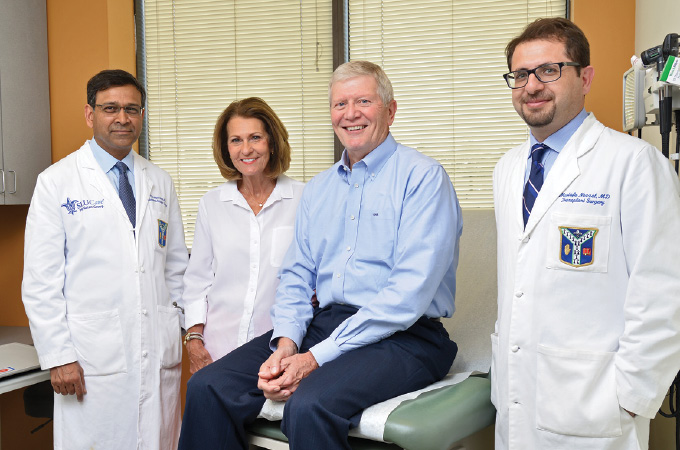It was routine blood tests that brought Karl Reinlein to the Saint Louis University Liver Center. His results showed increased levels of liver enzymes, which led to a diagnosis of nonalcoholic fatty liver disease (NAFLD). For many people, the condition doesn’t cause any problems, but Reinlein had nonalcoholic steatohepatitis (NASH), a more serious form of the disease that can cause liver failure. A transplant was necessary, and this month, he is looking forward to celebrating the first anniversary of his successful surgery.
Before beginning treatment, Reinlein consulted multiple nationally renowned liver centers. He found that the credentials of Saint Louis University met or exceeded those of much larger institutions, and the personal attention he received was unparalleled. “The quality of care, skill and compassion of the doctors and medical staff has been excellent,” he says. “I couldn’t have asked for a better group to work with.” The center is dedicated to diagnosing and treating all forms of liver disease and is a national leader in research and clinical trials.
Reinlein was lucky to receive a transplant. Dr. Mustafa Nazzal, a SLUCare transplant surgeon, notes that around 8,000 liver transplants are performed every year, but more than 13,000 patients are on the wait list at any time. “People are losing their lives to liver disease because there aren’t enough organs,” he notes, adding that the problem is not only due to a lack of donors. “We have to reject 10% of the organs we look at for transplants. If the liver is fatty, it won’t perform well after the surgery, and the same is true of organs from people of an advanced age.”
Currently, the SLU Liver Center is conducting research to increase the donor pool. Scientists use a normothermic perfusion pump to study organs that have been rejected for transplant. The unique technology recreates the conditions of a living human body and allows researchers to directly test the liver. “We’re hoping to develop medications that can improve the quality of donated organs and also reduce the amount of fat in living patients,” Nazzal explains.
Groundbreaking research like this is supported by Friends of the SLU Liver Center. The nonprofit, founded by patients and community members in 2003, has raised more than $4.6 million, which allows researchers to apply for external funding. The current return on investment is $16 for every $1 donated. On Oct. 26, the Friends group will host its 17th annual Diamonds Gala at The Chase Park Plaza. The evening includes a cocktail reception, dinner and live auction. “We are so grateful for our donors,” Tetri says. “Their generosity supports talented investigators who are studying all forms of liver disease.”
Friends of the SLU Liver Center’s 17th annual Diamonds Gala Oct. 26 at The Chase Park Plaza supports groundbreaking research to treat and cure liver disease. Pictured on the cover: Dr. Chintalapati Varma, Karl and Kathy Reinlein, Dr. Brent Tetri, Dr. Mustafa Nazzal. For more information, call 314.576.3078 or visit friendsoftheslulc.org.
Cover design by Julie Streiler | Cover photo by Bill Barrett
Pictured at top: Dr. Chintalapati Varma, Kathy and Karl Reinlein, Dr. Mustafa Nazzal
Photo: Bill Barrett
